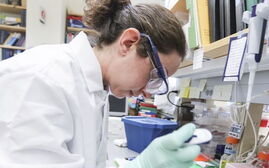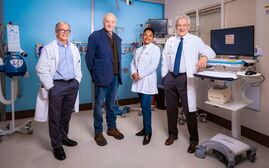From coffee roasters to biomed labs — businesses save big with energy efficiencies
At Caravan Beads, owner Barry Kahn hired ReVision Energy last year to install 264 photovoltaic panels, each 260 watts, on the roof of his 22,000-square-foot retail store and warehouse.
The solar array, which generates 68 kilowatts of electricity, is the largest photovoltaic array in Portland, although it will soon likely be eclipsed by a larger one in development at Bayside Bowl.
Caravan Beads, a Portland wholesaler and retailer of beads and beading supplies used by jewelry artists, installed the array based on the success of a smaller set-up on the owner's adjacent building, which is used for office space. The company also uses heat pumps for heating, cooling and hot water. Kahn has seen the bundled bill drop from $900 to $200.
“That was encouraging,” says Kahn. “It's nice to have essentially no electric bill.”
Caravan Beads further reduced its energy footprint with LED lights and timers and motion sensors on the lights
Developments like these illustrate the growing popularity not only of solar energy, but also technologies such as heat pumps and LED lighting that can save businesses money while reducing their carbon footprint.
Costs drive energy decisions
Kahn's is a common sentiment among business owners who are installing alternative energy systems, usually taking a comprehensive look at the variety of measures they can take to reduce costs and their carbon footprint.
At ReVision, marketing manager Jennifer Hatch says solar energy continues to grow in popularity as panel prices come down, in combination with a 30% federal tax credit available for businesses and continued developments in other technologies, such as the growing efficiency of heat pumps.
“When we first opened in 2003, solar electricity was 20% of our business,” says Hatch. “Now it's 80% or more of our business. The low cost of solar panels is driving the solar electric market.”
Initial capital investment has dropped 75% over the past decade, Hatch says, while the payback period has fallen from 20 years to nine years. Priced per watt, the cost of solar panels has dropped from $8 per watt in 2007 to $3 today, making Maine one of the least expensive states in the nation for solar energy.
“That's a big difference when you're talking about 10,000 watts or more,” Hatch says.
The federal credit was set to be reduced from 30% to 10% in January 2017, but has been extended by five years. Some solar systems are eligible for five-year accelerated depreciation if claimed as a business expense. And the Maine office of the U.S. Department of Agriculture expanded eligibility for its Renewable Energy for America Program, which offers grants for up to 25% of the cost of renewable energy systems and energy efficiency projects. Federal programs are especially important since, currently, there are no state-level incentives in Maine for commercial solar projects.
Still, solar users and providers are warily eyeing a review of the net-metering system, brought to the Maine Public Utilities Commission.
While Maine does not have the massive solar installations seen in a northern New England counterpart, Vermont, installations have, in many cases, been initiated by small businesses.
In Portland, Coffee By Design added solar panels at its Washington Avenue building in 2012, saving about $2,000 a year on electricity costs, according to ReVision Energy. Aikido of Maine put 30 panels on its roof in June 2013, reducing its electric bill from $150 to $20 for 10 months of the year.
At Heliotropic Technologies in Boothbay Harbor, an installation includes a south-facing “solar wall,” a passive air-heating system with exterior metal cladding and internal collector system that radiates solar heat inward.
Back in Portland, Bayside Bowl plans to add 422 panels, each 265 watts, for a 111 kW system.
Businesses are generally combining solar installations with other energy initiatives, says Hatch.
“Lighting upgrades are easy,” she says. “And EfficiencyMaine offers rebates of up to $1,000 to businesses for heat pumps, so that's a great way to invest. And we're also seeing people gravitate toward electric vehicles. They're not as prevalent in Maine as in other parts of the country, but we're seeing them more and more and I think that will continue to grow.”
A multi-pronged approach
At Wicked Joe Coffee in Topsham, Bob and Carmen Garver have adapted the multi-pronged approach to reducing the company's carbon footprint. Two years ago, the Garvers converted a 25,000-square-foot former navy commissary to a coffee roasting facility.
ReVision Energy installed a rooftop PV array of 14 255-watt panels, for a 3.57kW system. The system includes an electric car charging station that can be used by the public.
Two years ago, Garver was optimistic that all of this new technology would work out. His optimism was rewarded.
“We're very happy with it,” he says. “The way our building is oriented, it's ideal. With a climate like Maine, if you can add a solar wall, it's very productive. That and the electric vehicles were the bigger surprises in terms of how well they work
Two electric vehicles and a hybrid are part of their delivery fleet. Super-efficient coffee roasters reduce energy consumption and greenhouse gas emissions by up to 80%. Other measures include LED lighting with smart controls, an electric forklift and an efficient air compressor system.
They also look at sustainability throughout their supply chain, specializing in organic, Fair Trade and bird friendly coffees. An extensive recycling program shares chaff, grounds and burlap sacks with local organic farms and gardeners. They were recently certified as a B Corp.
“The PV system works out great,” Garver says. “We're talking about expanding that and possibly even creating a solar farm for our employees and neighbors.”
The facility has plenty of roof space for a PV expansion. The current system is providing a portion of their electricity; a long-term goal is to have an expanded array cover all their electricity consumption in stages, plus benefit either an employee or community group.
“We're growing, and we're using more energy as we grow. The first year in that facility, we grew 25%, and we're up 35% to 40% year-to-date this year, so our energy needs are increasing,” Garver says.
He continues to think about his company's carbon footprint.
“Oftentimes, when we're doing things, it's hard to quantify what the return might be on any particular investment,” he says. “But if people don't invest in these technologies, they'll never become cost-effective. So we want to invest in things because we understand that if no one is willing to go on the dance floor first, then the party is over.”
A learning curve at Jackson Lab
Another major energy-saving initiative that's worked out well is the biomass boiler installed at The Jackson Laboratory, a nonprofit biomedical research institution in Bar Harbor. The boiler burns Maine-sourced wood pellets to generate steam for heat and conversion to electricity.
Five years after installation, facilities engineer Norm Burdzel says the operation has come with a learning curve, but performance has been great.
Burning just over 10,000 tons of pellets per year, the system displaces 75%, or 1.12 million gallons, of the No. 2 fuel oil the lab previously used. From 2012-15, the lab saved $1.5 million a year by burning pellets rather than No. 2 fuel oil.
“The current energy market is trending with fossil fuels on par with pellets, but we will continue burning pellets for the near future due to the Maine economic advantages — Maine-sourced wood, pellets, trucking, etc. — and favorable pellet pricing,” says Burdzel.
The high-performance, low-emission burner system, manufactured by the Swedish company Petro Bio, is the first and only one of its kind operating in the United States, Burdzel says. Electrical output from an accompanying steam turbine covers some of the lab's use as well, although performance has not been maximized yet.
“It took a year or so to get the plant fully tuned, and to get our plant operations staff to understand the technology fully,” he says. “The boiler relies on how well we grind up the pellets into dust. A bigger particle won't burn as efficiently as a fine particle, but too fine a particle will burn too quickly. So we spent a year developing quality specifications with our wood suppliers and perfecting the screens in our mills to get the optimum consistency. Plus, we have European technology, so everything is metric. It took time to dial in with our vendors.”
Jackson Lab is planning its conversion of a former Lowe's Home Improvement store in Ellsworth into a mouse-production facility. Energy efficiency will be a key consideration at the 136,000-square-foot site, slated to open by the end of 2017.
“We're evaluating all options,” says Burdzel. Like the Bar Harbor campus, features will include high-efficiency chillers, variable-speed drives on all motors and waste heat-recovery systems.
Burdzel adds: “We're not going to rule out solar. We have a huge building with a big, flat roof.”
Read more
Maine’s largest solar farm could come to Farmington, but where?
Cooperative building Bar Harbor solar farm
Portland officials give the OK to Ocean Avenue solar project
Ashland pellet mill to boost employment after landing UMFK contract
Farmers' Almanac predicts big savings with expansive solar array
Coffee By Design earns Certified B sustainability recognition
















Comments